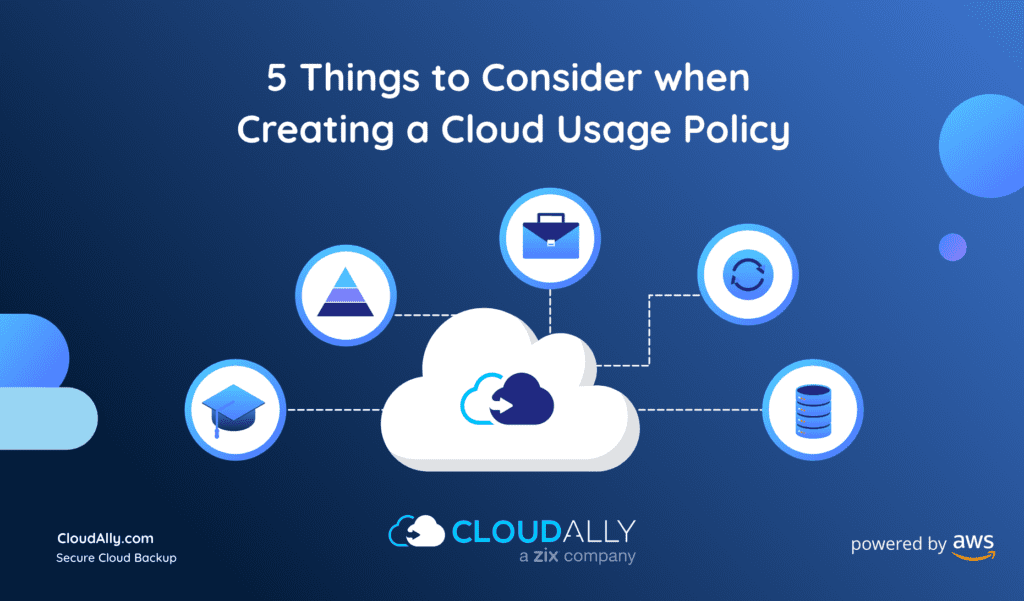Cloud Computing for Cloud for Backup is essential for business activities
Cloud computing serves as a major tool for enabling a collaborative work environment and has become the norm in almost all companies. But, adopting cloud solutions is still viewed as a fresh and new concept in many organizations and there seems to be very few or no standard policies and procedures to regulate cloud usage. This places a great risk on the success of cloud adoption because data placed in the cloud will always be vulnerable unless it is protected by strong cloud usage policies.
Also, if you are willing to do something, you better do it right: formulate the right usage policy and procedures to make the migration to the cloud a truly successful venture. Consider that cloud for backup is imperative as well.
What this article is about:
Here are the greatest concerns that you must address, while you create a cloud usage policy for your organization:
1. User Access Levels
If you plan to implement strong authentication and authorization mechanisms to access the cloud, then you must already have a strong definition of the various access levels and privileges that each employee in your organization will have. For instance, IT heads may have a greater need for certain data which are irrelevant for a project manager and vice versa.
Make use of privilege principles and fine-grained access levels to determine who can access a particular piece of data or application placed in the cloud and when can they do so. This will depend on your company’s organizational structure, staff hierarchy, and workflow.
2. Training
Migrating to the cloud mandates that at least a basic level of training should be given to your employees.
The extent of the training will depend on the various parameters of the cloud and the specific types of documents and applications that your employees will be using through the cloud.
Your employees need to have a good understanding of how the cloud and data flow work within the cloud environment to be able to take proactive steps in protecting the confidential data. They should also be cognizant of the rules of using the cloud, such as the password policies and access levels that you have established for regulating cloud usage. Training is greatly needed to make this possible.
3. Persistence of Data
This is an important parameter that you need to consider before moving your documents and sensitive information to the cloud.
There has to be a predetermined lifespan for all data that you move to that cloud because you never know when a small leak could happen which could expose sensitive data to unwanted interceptors.
You might even forget about the existence of certain data which may prove to be harmful in the long run. Even if you allow non-confidential data to reside in the cloud indefinitely, confidential data should always be accompanied by a timestamp to avoid complications in the future. The chances are that you may change your cloud service provider or you may move to some other means for collaboration.
The cloud is never permanent and you should always make sure your data resides in the cloud only for as long as it is used. You can include this timing specification in your cloud usage policy.
4. Legal Issues
There are certain data that must never be made public and there are certain other data which you should never have in your possession. For instance, sensitive information like health data must not be placed in a public cloud domain and you cannot illegally store your competitor’s data in your cloud.
The frequency and duration of cloud usage may also fall under certain legalities. Uploading corporate data into a public cloud site is also considered inappropriate. Similarly, downloading company data onto personal drives may also be considered an offense. You must make sure to include all of the legal compliances that your company must adhere to in your cloud usage.
5. Backups
Mishaps can happen anytime and you must always be ready for the worst. But, the sad truth is that many organizations only realize the need for backup solutions after an incident and when they have already paid for the loss.
Many cloud service providers do not offer cloud for backup unless asked and may not even have proper backup systems in place. They may have it for themselves, but if you store your data on the cloud, then you are responsible for it.
If you have not installed backup systems earlier, getting back lost data can be very expensive and difficult. Hence, it is best to be on the safer side and include backup procedures and policies in your cloud usage policies.
One way to deal with this problem is by using cloud-to-cloud backup solutions that have been proven to be very useful for data recovery during failures. But, you need to be careful about these solutions too, because, once again, you are replicating your data into another cloud and you will need proper management and policies to maintain the backup cloud.
There is always a risk of data leakage when it comes to the cloud and your usage policy must address it along with the other issues already mentioned. Start to backup your Box for Business account with a Free 14 day trial.



